Vision 2025 - National Research Centre for Grapes
Vision 2025 - National Research Centre for Grapes
Vision 2025 - National Research Centre for Grapes
Create successful ePaper yourself
Turn your PDF publications into a flip-book with our unique Google optimized e-Paper software.
5.1.3 Crop Protection<br />
The imported disease <strong>for</strong>ecasting software tested by the <strong>Centre</strong> based on weather parameters<br />
viz. temperature, relative humidity, rainfall, leaf wetness, radiation, air velocity etc. was<br />
accepted by grape growers to know the level of disease incidence particularly downy mildew,<br />
powdery mildew and anthracnose and guidance of pesticide spray schedule. The system was<br />
suitable <strong>for</strong> <strong>for</strong>ecasting of downy mildew and anthracnose but not <strong>for</strong> powdery mildew. This<br />
technique has been accepted by the State Government of Maharashtra and Andhra Pradesh to<br />
use in other crops. Similarly the expert system developed by the <strong>Centre</strong> <strong>for</strong> powdery mildew<br />
<strong>for</strong>ecasting and management has been accepted by many growers. Older and newer pesticide<br />
molecules have also been evaluated <strong>for</strong> their bioefficacy and residue data and accordingly the<br />
PHI period was fixed <strong>for</strong> managing the various disease and insect pests in grape. This was<br />
worked out keeping in view the export of table grapes to EU countries and list of pesticides<br />
recommended under this study were taken as guidance <strong>for</strong> the pesticide residue monitoring<br />
programme implemented by the APEDA under the guidance of <strong>National</strong> Referral Laboratory<br />
set up at this <strong>Centre</strong>. Studies on the pest risk analysis of insect pests of quarantine importance<br />
carried out by this <strong>Centre</strong> in grape opened up the newer export market to China.<br />
5.1.4 Pre and post-harvest technology to improve shelf life<br />
A technique of pre-harvest spray of Trichoderma was received well by the farmers in<br />
managing disease incidence and post-harvest fungi. This has become common practice in view<br />
of the post-harvest decay problems faced in domestic and export market during long storage<br />
of produce.<br />
5.2 INPUT / OUTPUT ASSESSMENT<br />
5.2.1 Crop Improvement<br />
Introduction, evaluation and development of rootstock and scion varieties and their hybrids<br />
input has been successful to some extent. As a result, the rootstocks viz. Dogridge, B-2/56,<br />
110 R, 99 R, 1103 P, Salt Creek, St. George, Teleki 5A, SO4 etc. are under investigation of<br />
compatibility with various table and wine grape varieties under various biotic and abiotic<br />
stresses. No new developed varieties in the country have become popular or accepted by the<br />
farmers except the Thompson Seedless and its clones developed by them. Introduced varieties<br />
viz. Sharad Seedless, Flame Seedless and Red Globe are being accepted under various<br />
situations and different agroclimatic conditions. Clonal selection identified by the <strong>Centre</strong> viz.<br />
A 17/3 from Centennial Seedless, Kishmish Rozavis White from Kishmish Rozavis and<br />
A 18/3, a black seedless selection from an open pollinated seedling progeny of a black seeded<br />
variety are promising and are under field evaluation at different places in the country. Input put<br />
up <strong>for</strong> biotechnology studies just few years back will give the output in the years to come.<br />
5.2.2 Crop Production<br />
Input in the area of training method and various material used <strong>for</strong> fabrication is yet to give<br />
appropriate output in reducing the initial cost of cultivation. Level of pruning, time of pruning<br />
in various grape varieties and their combination is also to give specific output in getting offseason<br />
crop and appropriate yield.<br />
Input in terms of use of various bioregulators <strong>for</strong> crop regulation / thinning, increasing size of<br />
berry and pedicel thickness apart from managing growth / vigour, breaking dormancy of buds<br />
etc. has given many benefits so far.<br />
Experiments on increasing efficiency of water and fertilizer use have given specific and<br />
14


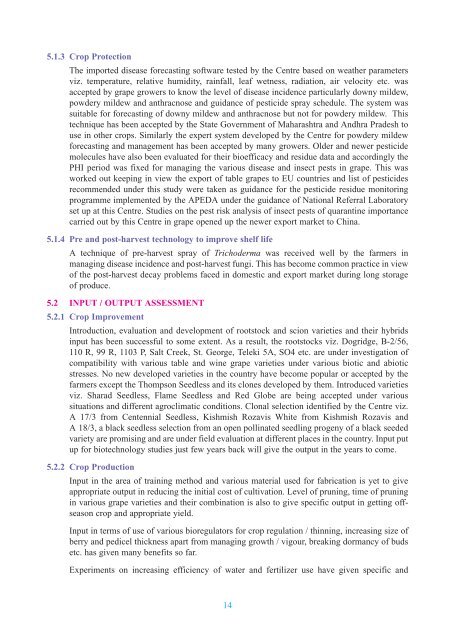


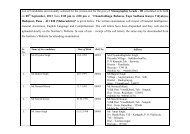
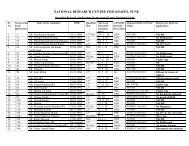

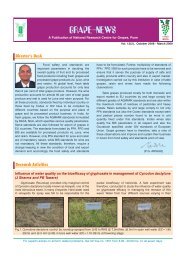

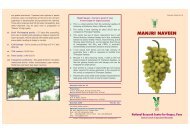
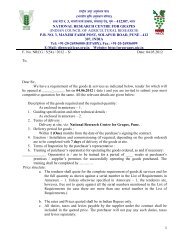



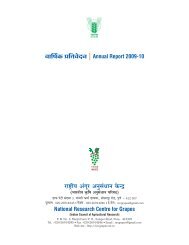
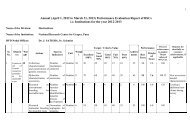
![mj]mJ{V cmcH$m{irM{ (_mBQâ¤>g) oZ`ÃÃU](https://img.yumpu.com/33367555/1/190x127/mjmjv-cmchmirm-mbqag-ozaau.jpg?quality=85)